Why a National EV Network of Chargers Is a Big Win for C-stores
With electric vehicles (EV) hitting the market at a quickening pace and chargers becoming more ubiquitous, the White House Administration’s plan to create a first-of-its-kind national EV charging grid is garnering significant attention. A component of the 2021 Bipartisan Infrastructure Law, this national network is intended to instill confidence among American drivers that investing in an EV won’t leave them stranded.
What does this proposed national EV network include? A combined $7.5 billion in federal funds was distributed among states to purchase and install chargers along major roads. Funds will dictate the frequency of placement and require chargers to be accessible to all. Rural and underserviced neighborhoods will receive priority consideration.
The Opportunity for C-store Owners
Think these national charging efforts will keep all current and future EV drivers on the road? Think again. The national charging efforts are not an absolute fix to facilitating greater EV accessibility. Even when accounting for an increase in at-home charging stations, there is bound to be a significant shortage in charging unit supply across the nation, if solely relying on this government infrastructure.
Estimates project that at the anticipated rate of EV production and adoption, the United States will run approximately 600,000 charging units shy of national needs in the next three to four years, according to IHS Markit. This shortage provides an opportunity for c-stores and gas stations to shine.
Drivers already consider gas station stopoffs as essential to keep them moving. Incorporating EV chargers is the natural next step and an easy mental shift for consumers.
The upside for site owners is that rather than captivating their audience for a mere few minutes as with a traditional fuel-up, they now have the chance to engage that customer for upwards of 30 minutes in one visit. Extended customer time on-site could be a monumental win for c-stores that lean into sound customer experience, cross-promotion, and loyalty acquisition/retention practices.
As with any other customer, drivers of electric vehicles are looking for fast charging in a safe, comfortable location. This means it’s important when designing charging stations to ensure they are set up like other fueling points on the forecourt. Well-lit spots not too far from the store with weather protection and receptacles can go a long way in providing sought-after conveniences.
Beyond that, c-stores can elevate the experience with technology to showcase expanded food and beverage options, add-on services, or even loyalty points programs geared toward the unique needs of their EV customers.
Understanding Whether EV Charger Integration Makes Sense for Your Forecourt
Charging units have the potential to bring in incremental revenue over time, but they do come at a higher upfront cost. While charging stations could be a wise investment for some site owners, it’s important to consider several factors before deciding whether they make sense for your forecourt.
A great place to start is to talk to similar businesses that have already implemented EV charging stations and find out what has worked, what hasn’t, and what they wish they knew before investing. Keep in mind there are a range of power outputs, configurations and price points, so you’ll want to ensure you select the one that works best for your needs.
Local regulations and market needs, as well as having a solid resource plan to account for necessary capital investments, should factor into your decision on when and how to get into EV charge offerings. For example, be sure to check the local rules regarding EV charger installation around other devices at a convenience store.
EV charging needs will vary depending on where the store is located, the number of local registered EVs, and the local utility regulation defining whether pay-for-charging is allowed.
It’s good to check out what the adoption rates are in the local market to understand the necessary factors involved in determining whether there is a return on investment for the business. Some markets will incentivize consumers to buy an EV, and some regions have more EV adoption than others.
With strategic planning, c-stores are positioned to become a fundamental complement to the national EV charging network as it grows. The golden twist is the positive impact it can have on your business sustainability and the growth of your customer base.
Scott Negley is the senior director of product management at Dover Fueling Solutions where he takes his understanding of customer needs to develop products that result in successful business outcomes. For more information, visit doverfuelingsolutions.com.
Editor's note: The opinions expressed in this column are the author's and do not necessarily reflect the views of Convenience Store News.

